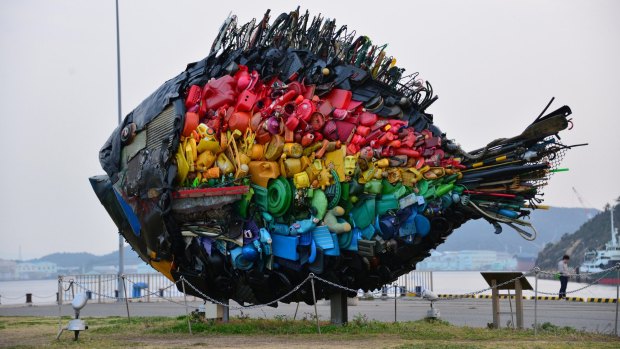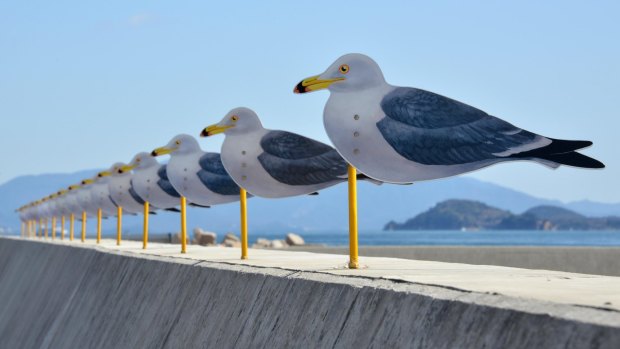This was published 7 years ago
Artful island of Kagawa: Why Japan's least visited island is its best
By Jamie Lafferty

The "Chinu, Black Sea Bream of Uno", by Yodogawa Technique, on display at the port of Uno as part of the Setouchi Art Triennale.Credit: Alamy
They say as many as 90 per cent of first-time visitors to Japan don't stray from the Golden Route, the well trodden, bullet-train ploughed path west from Tokyo to Osaka. History buffs may venture as far as Hiroshima, winter sports fans may detour to Nagano, divers to Okinawa, but very, very few will make it to tiny Kagawa.
Japan's smallest prefecture, you may have only heard of it before during a particularly tricky pub quiz. For Japanese, the region formerly known as Sanuki is most famous for its superlative udon, which most people agree is the best in the country. But for foreigners, why go there? There are 46 other prefectures, all of them larger, and presumably with much more to offer, right?
Not at all. On an average year, little Kagawa punches far above its weight, with a combination of culture and retail unmatched by many other prefectures. And then, once every three years – including 2016 – it hosts the astonishing Setouchi Art Triennale.

The "Sea Gulls' Parking Lot", by Takahito Kimura, at Megijima island in Kagawa prefecture, Japan's southern island of Shikoku.Credit: Alamy
Presented across three different seasons, the Triennale would be a boon to any region in Japan, but here, on the northern shores of Shikoku, the least visited and most poorly understood of Japan's four major islands, it seems miraculous.
The spring section took place for a few short weeks at the end of March and start of April, while the summer instalment will run from July 18 until September 4. The programme will come to a close with the autumn segment, from October 8 until November 6.
Quite what to expect is not easily summarised. There are dozens of artists from around the world working in almost every medium imaginable, their work presented across a dozen Kagawan islands in the Seto Inland Sea. Until the Triennale was founded in 2010, few Japanese would have had much occasion to visit these islands, never mind foreigners. Now, ordinarily sleepy islands such as Honjima and Ogijima, with their ageing populations and Japan-wide urbanisation issues, are transformed into hubs for international artists to display artwork. The comparatively massive Shodoshima – usually remarkable only in that it produces Japan's small batches of olive oil – sees enormous art installations arrive and abandoned buildings transformed into living pieces.
The decay of these communities features in many of the works of art, and in particular their setting. Some take place in abandoned schools, the villages having simply, depressingly, run out of young people to attend them. "We are holding the Setouchi Triennale in hope of bringing this vitality back to these islands, where nature and the lifestyles of the people have coalesced together," say the organisers, who have titled this year's Triennale "Restoration of the Sea".
Whether some of the most remote islands will benefit from having traditional houses converted into light-and-sound artworks, or their ports clad in chrome as part of a garish artwork remains to be seen. Yet elsewhere, permanent installations have critics raving.
Part of the Triennale, but available to visit at at time of the year, the art pieces found on Teshima and Naoshima are among the most ambitious and affecting anywhere in Japan.
The former is home to the eerily and ethereal Teshima Art Museum, a dull name for one of the most tranquil yet immersive works of art anywhere in Asia. It doesn't quite defy description, but it's impossible to adequately relay the feeling of being there. A huge dome with an open roof, it is seemingly empty, a man-made cave of brushed concrete. Photographs, phones and talking are banned inside, and to walk in is to initially wonder what the point of it all is. On the floor, droplets of water seep up from tiny pumps, growing until big enough to scuttle across the concrete as though alive. Watching them gather in pools across the art feels like watching some kind of strange, muted safari.
If that all sounds a little too wacky for its own good, then Naoshima's Benesse Art Site offers a slightly more conventional take with sculptures, including works by polka-dot fanatic Yayoi Kusama, and paintings from French impressionist Claude Monet. Hundreds of millions of dollars of art has been gathered here and is open to the public all year. Triennale year or not, magic has been gathered on those islands.
TRIP NOTES
MORE INFORMATION
GETTING THERE
Takamatsu is the hub from which the islands can be reached. A three-day ferry pass is available for Triennale visitors (setouchi-artfest.jp). Takamatsu itself is linked to the mainland and its wonderful bullet-train network by a slower train to Okayama (japanrailpass.com). Alternatively, it has a small airport, with links to Tokyo, though the train may well prove more cost effective, and certainly more scenic.
Jamie Lafferty was a guest of Shikoku Tourism
Sign up for the Traveller Deals newsletter
Get exclusive travel deals delivered straight to your inbox. Sign up now.